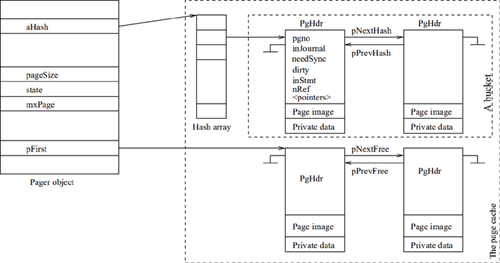Section 3.3. Cache Management
Page Cache Management > Cache Management
3.3. Cache Management
SQLite maintains a separate page cache for each open database file. If a thread opens the same file two or many times, the pager creates and initializes a separate page cache for the file only at the first open call. If two or more threads open the same file, there will be many independent caches for the same file. In-memory databases do not refer to any external storage devices. But, they are also treated like ordinary native files, and are stored entirely within the cache. Thus, the B/B+-tree module uses the same interface to access either type of database.
NOTE
Page caches reside in an application's memory space. Note that the same pages may be cached by the native operating system. When an application reads a piece of data from any file, the operating system normally makes its own copy of the data first, and then a copy in the application. We are not interested in knowing how the operating system manages its own cache. SQLite's page cache organization and management are independent of those of the native operating system.
Management of page cache is crucial for system performance. The following subsections discuss how the pager organizes and maintains page cache, and how cache clients read and modify cache elements.
3.3.1. Cache organization
In general, to speed up searching a cache, the currently held in-cache items are well organized. SQLite uses a hash table to organize cached pages, and uses page-slots to hold pages in the table. The cache is fully associative, that is, any slot can store any page. The hash table is initially empty. As page demand increases, the pager creates new slots and inserts them in the hash table. There is a maximum limit on the number of slots a cache can have. (In-memory databases have no such limit so long as the native operating system allows the application space to grow.)
Figure 3-2. Page cache

Figure 3-2 depicts a typical cache layout. Each page in the hash table is represented by a header object of PgHdr type. The page image is stored after the PgHdr object. The image is followed by a piece of private data that is used by the B+-tree module to keep page-specific control information there. (In-memory databases have no journal file, so their recovery information is recorded in in-memory objects. Pointers to those objects are stored following the private part: these pointers are used by the pager only.) This (additional nonpage) space is initialized to zeros when the pager brings the page into the cache. All pages in the cache are accessible via a hash array, namely aHash in the Pager object; the array size is fixed when the SQLite library is compiled. Each array element points to a "bucket" of pages; pages in each bucket are organized in an unordered doubly linked list.
The PgHdr is only visible to the pager module, and not visible to the B+-tree and higher-level modules. The header has many control variables. The pgno variable identifies the page number of the database page it represents. The injournal variable is true if the page has already been written to the rollback journal. The needSync variable is true if the journal needs a flush before writing this page back in the database file. (A flush on a file transfers modified parts of the file to the disk surface.) The dirty variable is true if the page has been modified, and the new value is not yet written back to the database file. The inStmt variable is true if the page is in the current statement journal. The nRef variable is the reference count on this page. If the nRef value is greater than zero, the page is in active use, and we say that the page is pinned down; otherwise, the page is unpinned and free. There are many pointer variables in PgHdr object (not all of them are shown in the figure). The pNextHash and pPrevHash pointers are used to link together pages in the same hash bucket. The pNextStmt and pPrevStmt pointers link together those pages that are in the statement journal. (I talk about the statement journal later.) The pNextFree and pPrevFree pointers are used to link together all free pages. Free pages are never taken out of hash buckets, even though the above figure seems to suggest otherwise. All pages (free or not) in the cache are linked together through the pNextAll pointer. The pDirty pointer links together all dirty pages. Note that a free page can be dirty, too.
3.3.2. Cache read
The cache is referenced by using a search key the page number. To read a page, the client B+-tree module invokes the sqlite3pager_get pager API function on the page number. The function performs the following steps for a page P:
-
It searches the cache space.
-
It applies a hash function on P and gets an index. (SQLite uses a very simple hash function to determine the index value: page number modulo the size of the aHash array.)
-
It uses the index into the aHash array and gets the hash bucket.